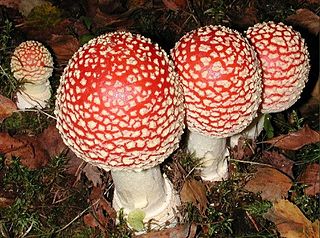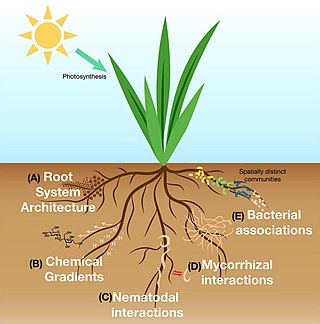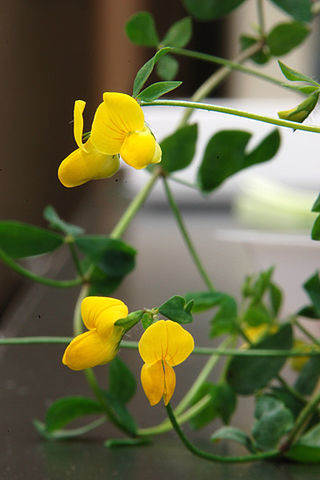Related Research Articles

A mycorrhiza is a symbiotic association between a fungus and a plant. The term mycorrhiza refers to the role of the fungus in the plant's rhizosphere, the plant root system and its surroundings. Mycorrhizae play important roles in plant nutrition, soil biology, and soil chemistry.

Leghemoglobin is an oxygen-carrying phytoglobin found in the nitrogen-fixing root nodules of leguminous plants. It is produced by these plants in response to the roots being colonized by nitrogen-fixing bacteria, termed rhizobia, as part of the symbiotic interaction between plant and bacterium: roots not colonized by Rhizobium do not synthesise leghemoglobin. Leghemoglobin has close chemical and structural similarities to hemoglobin, and, like hemoglobin, is red in colour. It was originally thought that the heme prosthetic group for plant leghemoglobin was provided by the bacterial symbiont within symbiotic root nodules. However, subsequent work shows that the plant host strongly expresses heme biosynthesis genes within nodules, and that activation of those genes correlates with leghemoglobin gene expression in developing nodules.

Rhizobia are diazotrophic bacteria that fix nitrogen after becoming established inside the root nodules of legumes (Fabaceae). To express genes for nitrogen fixation, rhizobia require a plant host; they cannot independently fix nitrogen. In general, they are gram negative, motile, non-sporulating rods.

Ensifer meliloti are an aerobic, Gram-negative, and diazotrophic species of bacteria. S. meliloti are motile and possess a cluster of peritrichous flagella. S. meliloti fix atmospheric nitrogen into ammonia for their legume hosts, such as alfalfa. S. meliloti forms a symbiotic relationship with legumes from the genera Medicago, Melilotus and Trigonella, including the model legume Medicago truncatula. This symbiosis promotes the development of a plant organ, termed a root nodule. Because soil often contains a limited amount of nitrogen for plant use, the symbiotic relationship between S. meliloti and their legume hosts has agricultural applications. These techniques reduce the need for inorganic nitrogenous fertilizers.

Root nodules are found on the roots of plants, primarily legumes, that form a symbiosis with nitrogen-fixing bacteria. Under nitrogen-limiting conditions, capable plants form a symbiotic relationship with a host-specific strain of bacteria known as rhizobia. This process has evolved multiple times within the legumes, as well as in other species found within the Rosid clade. Legume crops include beans, peas, and soybeans.

Nod factors, are signaling molecules produced by soil bacteria known as rhizobia in response to flavonoid exudation from plants under nitrogen limited conditions. Nod factors initiate the establishment of a symbiotic relationship between legumes and rhizobia by inducing nodulation. Nod factors produce the differentiation of plant tissue in root hairs into nodules where the bacteria reside and are able to fix nitrogen from the atmosphere for the plant in exchange for photosynthates and the appropriate environment for nitrogen fixation. One of the most important features provided by the plant in this symbiosis is the production of leghemoglobin, which maintains the oxygen concentration low and prevents the inhibition of nitrogenase activity.

An arbuscular mycorrhiza (AM) is a type of mycorrhiza in which the symbiont fungus penetrates the cortical cells of the roots of a vascular plant forming arbuscules. Arbuscular mycorrhiza is a type of endomycorrhiza along with ericoid mycorrhiza and orchid mycorrhiza. They are characterized by the formation of unique tree-like structures, the arbuscules. In addition, globular storage structures called vesicles are often encountered.

The rhizosphere is the narrow region of soil or substrate that is directly influenced by root secretions and associated soil microorganisms known as the root microbiome. Soil pores in the rhizosphere can contain many bacteria and other microorganisms that feed on sloughed-off plant cells, termed rhizodeposition, and the proteins and sugars released by roots, termed root exudates. This symbiosis leads to more complex interactions, influencing plant growth and competition for resources. Much of the nutrient cycling and disease suppression by antibiotics required by plants occurs immediately adjacent to roots due to root exudates and metabolic products of symbiotic and pathogenic communities of microorganisms. The rhizosphere also provides space to produce allelochemicals to control neighbours and relatives.
Horizontal transmission is the transmission of organisms between biotic and/or abiotic members of an ecosystem that are not in a parent-progeny relationship. Because the evolutionary fate of the agent is not tied to reproductive success of the host, horizontal transmission tends to evolve virulence. It is therefore a critical concept for evolutionary medicine.

Bradyrhizobium is a genus of Gram-negative soil bacteria, many of which fix nitrogen. Nitrogen fixation is an important part of the nitrogen cycle. Plants cannot use atmospheric nitrogen (N2); they must use nitrogen compounds such as nitrates.
Actinorhizal plants are a group of angiosperms characterized by their ability to form a symbiosis with the nitrogen fixing actinomycetota Frankia. This association leads to the formation of nitrogen-fixing root nodules.
Microbial inoculants, also known as soil inoculants or bioinoculants, are agricultural amendments that use beneficial rhizosphericic or endophytic microbes to promote plant health. Many of the microbes involved form symbiotic relationships with the target crops where both parties benefit (mutualism). While microbial inoculants are applied to improve plant nutrition, they can also be used to promote plant growth by stimulating plant hormone production. Although bacterial and fungal inoculants are common, inoculation with archaea to promote plant growth is being increasingly studied.

Lotus japonicus is a wild legume that belongs to family Fabaceae. Members of this family are very diverse, constituting about 20,000 species. They are of significant agricultural and biological importance as many of the legume species are rich sources of protein and oil and can also fix atmospheric nitrogen.

Bradyrhizobium japonicum is a species of legume-root nodulating, microsymbiotic nitrogen-fixing bacteria. The species is one of many Gram-negative, rod-shaped bacteria commonly referred to as rhizobia. Within that broad classification, which has three groups, taxonomy studies using DNA sequencing indicate that B. japonicum belongs within homology group II.

enod40, also known as early nodulin 40, is a gene found in flowering plants. The gene has characteristics of both protein and Non-coding RNA genes. There is some evidence that the non-coding characteristics of this gene are more widely conserved than the protein coding sequences. In soyabeans enod40 was found to be expressed during early stages of formation of nitrogen-fixing root nodules that are associated with symbiotic soil rhizobial bacteria. The gene is also active in roots containing fungi forming phosphate-acquiring arbuscular mycorrhiza. An interaction with a novel RNA-binding protein MtRBP1 investigated in the development of Root nodule suggests ENOD40 has a function of cytoplasmic relocalization of nuclear proteins. In the study of non-legume plants, the over-expression of ENOD40 in transgenic Arabidopsis lines was observed a reduction of cell expansion.
Nitrogen nutrition in the arbuscular mycorrhizal system refers to...

An ectomycorrhiza is a form of symbiotic relationship that occurs between a fungal symbiont, or mycobiont, and the roots of various plant species. The mycobiont is often from the phyla Basidiomycota and Ascomycota, and more rarely from the Zygomycota. Ectomycorrhizas form on the roots of around 2% of plant species, usually woody plants, including species from the birch, dipterocarp, myrtle, beech, willow, pine and rose families. Research on ectomycorrhizas is increasingly important in areas such as ecosystem management and restoration, forestry and agriculture.
Mesorhizobium mediterraneum is a bacterium from the genus Mesorhizobium, which was isolated from root nodule of the Chickpea in Spain. The species Rhizobium mediterraneum was subsequently transferred to Mesorhizobium mediterraneum. This species, along with many other closely related taxa, have been found to promote production of chickpea and other crops worldwide by forming symbiotic relationships.

A symbiosome is a specialised compartment in a host cell that houses an endosymbiont in a symbiotic relationship.

The common symbiosis signaling pathway (CSSP) is a signaling cascade in plants that allows them to interact with symbiotic microbes. It corresponds to an ancestral pathway that plants use to interact with arbuscular mycorrhizal fungi (AMF). It is known as "common" because different evolutionary younger symbioses also use this pathway, notably the root nodule symbiosis with nitrogen-fixing rhizobia bacteria. The pathway is activated by both Nod-factor perception, as well as by Myc-factor perception that are released from AMF. The pathway is distinguished from the pathogen recognition pathways, but may have some common receptors involved in both pathogen recognition as well as CSSP. A recent work by Kevin Cope and colleagues showed that ectomycorrhizae also uses CSSP components such as Myc-factor recognition.
References
- 1 2 "Prof. Martin Parniske". LMU Munich, Faculty of Biology, Genetics. Retrieved 2017-02-07.
- ↑ Wegel E, Schauser L, Sandal N, Stougaard J, and Parniske M. 1998. Mycorrhiza Mutants of Lotus japonicus Define Genetically Independent Steps During Symbiotic Infection. Molecular Plant Microbe Interactions 11: 933–936. link: http://apsjournals.apsnet.org/doi/abs/10.1094/MPMI.1998.11.9.933
- ↑ Stracke S, Catherine K, Satoko Y, Lonneke M, Shusei S, Takakazu K, Satoshi T, Sandal N, Stougaard J, Szczyglowski K, and Parniske M. A plant receptor-like kinase required for both bacterial and fungal symbiosis. Nature 417, no. 6892 (June 27, 2002): 959–62. doi : 10.1038/nature00841.
- ↑ Saito K, Yoshikawa M, Yano K, Miwa H, Uchida H, Asamizu E, Sato S, Tabata S, Imaizumi-Anraku H, Umehara Y, Kouchi H, Murooka Y, Szczyglowski K, Downie A, Parniske M, Hayashi M, and Kawaguchia M. NUCLEOPORIN85 is Required for Calcium Spiking, Fungal and Bacterial Symbioses, and Seed Production in Lotus japonicus. Plant Cell Volume: 19 Issue: 2 Pages: 610-624 Published: Feb 2007. doi : 10.1105/tpc.106.046938
- ↑ Groth M, Naoya T, Jillian P, Uchida H, Dräxl S, Brachmann A, Sato S, Tabata S, Kawaguchi M, Wang TL and Parniske M. NENA, a Lotus japonicus Homolog of Sec13, Is Required for Rhizodermal Infection by Arbuscular Mycorrhiza Fungi and Rhizobia but Dispensable for Cortical Endosymbiotic Development. Plant Cell Volume: 22 Issue: 7 Pages: 2509-2526 Published: Jul 2010. doi : 10.1105/tpc.109.069807
- ↑ Charpentier M, Bredemeier R, Wanner G, Takeda N, Schleiff E, and Parniske M. (2008). Lotus japonicus CASTOR and POLLUX Are Ion Channels Essential for Perinuclear Calcium Spiking in Legume Root Endosymbiosis. Plant Cell 20, 3467-3479. doi : 10.1105/tpc.108.063255
- ↑ Tirichine L, Imaizumi-Anraku H, Yoshida S, Murakami Y, Madsen LH, Miwa H, Nakagawa T, Sandal N, Albrektsen AS, Kawaguchi M, Downie A, Sato S, Tabata S, Kouchi H, Parniske M, Kawasaki S, and Stougaard J. Deregulation of a Ca2+/calmodulin-dependent kinase leads to spontaneous nodule development. Nature Volume: 441 Issue: 7097 Pages: 1153-1156 Published: Jun 28 2006. doi : 10.1038/nature04862
- ↑ Yano K, Yoshida S, Müller J, Singh S, Banba M, Vickers K, Markmann K, White C, Schuller B, Sato S, Asamizu E, Tabata S, Murooka Y, Jillian P, Wang TL, Kawaguchi M, Imaizumi-Anraku H, Hayashi M, Parniske M. “CYCLOPS, a mediator of symbiotic intracellular accommodation.” Proceedings of the National Academy of Sciences 105, no. 51 (December 23, 2008): 20540–45. doi : 10.1073/pnas.0806858105.
- ↑ Singh, S, Katzer K, Lambert J, Cerri M, and Parniske M. “CYCLOPS, a DNA-Binding Transcriptional Activator, Orchestrates Symbiotic Root Nodule Development.” Cell Host & Microbe 15, no. 2 (February 12, 2014): 139–52. doi : 10.1016/j.chom.2014.01.011
- ↑ Singh, S, Katzer K, Lambert J, Cerri M, and Parniske M. “CYCLOPS, a DNA-Binding Transcriptional Activator, Orchestrates Symbiotic Root Nodule Development.” Cell Host & Microbe 15, no. 2 (February 12, 2014): 139–52. doi : 10.1016/j.chom.2014.01.011.
- ↑ Parniske M, Hammond-Kosack KE, Golstein C, Thomas CM, Jones DA, Harrison K, Wulff BB, and Jones JD. “Novel Disease Resistance Specificities Result from Sequence Exchange between Tandemly Repeated Genes at the Cf-4/9 Locus of Tomato.” Cell 91, no. 6 (December 12, 1997): 821–32. doi : 10.1016/S0092-8674(00)80470-5.
- ↑ Parniske M, Jones JD. Recombination between diverged clusters of the tomato Cf-9 plant disease resistance gene family. Proceedings of the National Academy of Sciences of the United States of America Volume: 96 Issue: 10 Pages: 5850-5855 Published: MAY 11 1999. doi : 10.1073/pnas.96.10.5850
- ↑ Parniske M, Zimmermann C, Cregan PB, and Werner D. Hypersensitive Reaction of Nodule Cells in the Glycine Sp./Bradyrhizobium japonicum‐Symbiosis Occurs at the Genotype‐Specific Level. Botanica Acta 103, no. 2 (May 1, 1990): 143–48. doi : 10.1111/j.1438-8677.1990.tb00140.x
- ↑ Parniske M, Ahlborn B, Werner D. Isoflavonoid-inducible resistance to the phytoalexin glyceollin in soybean rhizobia. Journal of Bacteriology Volume: 173 Issue: 11. 3432-3439. Jun 1991. doi : 10.1128/jb.173.11.3432-3439.1991
- ↑ "Molecular inventions underlying the evolution of the nitrogen-fixing root nodule symbiosis". European Research Council. Retrieved 2017-02-05.
- ↑ The world's most influential scientific minds 2014, p. 90